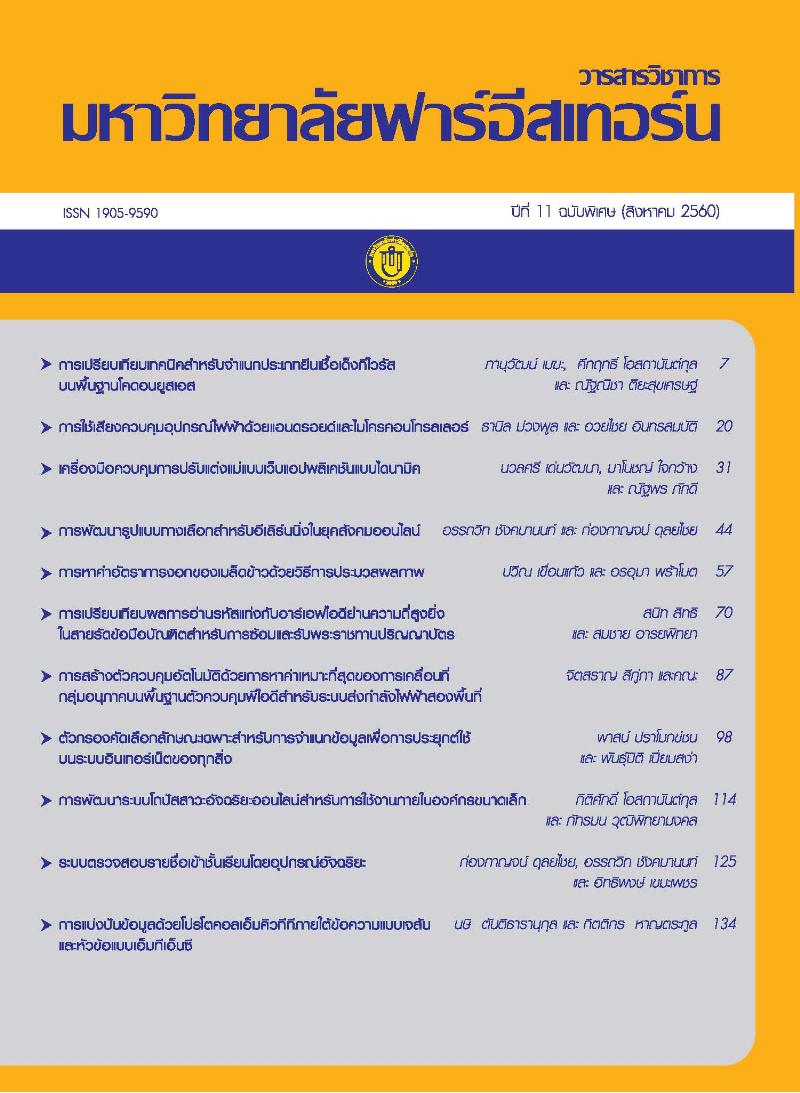การสร้างตัวควบคุมอัตโนมัติด้วยการหาค่าเหมาะที่สุดของการเคลื่อนที่กลุ่ม อนุภาคบนพื้นฐานตัวควบคุมพีไอดีสำหรับระบบส่งกำลังไฟฟ้าสองพื้นที่
Main Article Content
Abstract
บทความนี้นำเสนอการออกแบบตัวควบคุมพีไอดีสำหรับระบบการส่งกำลังไฟฟ้าระยะไกลสองพื้นที่
ในกรณีที่มีการเปลี่ยนแปลงอัตราการใช้กำลังไฟฟ้าในรูปแบบต่างๆ โดยตัวควบคุมพีไอดีเป็นตัวควบคุม
ที่ถูกใช้ควบคุมระบบการส่งกำลังไฟฟ้าระยะไกลสองพื้นที่ เนื่องจากมีโครงสร้างการควบคุมที่ง่ายกว่า
เมื่อเปรียบเทียบกับตัวควบคุมอื่นๆ แต่อย่างไรก็ตาม การปรับค่าอัตราขยายพีไอดีที่เหมาะสมยังเป็นประเด็น
ที่ยังได้รับการศึกษาเพื่อการปรับค่าให้ได้ค่าอัตราขยายที่มีประสิทธิภาพ บทความนี้จึงมีเป้าหมายเพื่อทำการ
เลือกค่าอัตราขยายที่เหมาะสมโดยใช้การหาค่าเหมาะที่สุดของการเคลื่อนที่กลุ่มอนุภาคเพื่อนำมาประยุกต์
ใช้ในการควบคุมระบบไฟฟ้ากำลังสองพื้นที่ โดยระบบนี้เป็นระบบที่มีการส่งสัญญาณความถี่ในระยะไกล
ระหว่างพื้นที่ผ่านทางสายส่ง ซึ่งเมื่อเกิดผลกระทบจากพื้นที่หนึ่งจะเกิดผลกระทบต่ออีกพื้นที่ที่เหลือ
โดยในบทความนี้เลือกใช้ค่าความคลาดเคลื่อนกำลังสองเฉลี่ยเป็นฟังก์ชันวัตถุประสงค์ในการเลือกอัตราขยาย
และเปรียบเทียบความถูกต้อง จากผลการจำลองและเปรียบเทียบพบว่าการควบคุมความถี่ของระบบส่งกำลัง
สองพื้นที่โดยพื้นฐานตัวควบคุมพีไอดีด้วยการเลือกอัตราขยายด้วยวิธีการเคลื่อนที่กลุ่มอนุภาค สามารถ
ควบคุมสัญญาณตามความถี่อ้างอิงได้อย่างเหมาะสมและมีประสิทธิภาพภายใต้การเปลี่ยนแปลงโหลดใน
รูปแบบต่างๆ
This paper presents a design of PID controllers for two area power systems with variation
in the load. Currently, PID controller has been used to operate in two area power system because
its structure is simpler compared to others. However, the issue of tuning and designing a PID
controller adaptively and efficiently is still open. This paper presents an improved PID controller
efficiency from tuning by Particle Swarm Optimization (PSO) Algorithm. The automatic generation
control has been developed for two area thermal network using PSO based PID controller. The two
control signals are thus developed by a PSO based PID controller, which are fed one to each area
for frequency response enhancement. The errors between desired frequency response and
actual frequency response are calculated by using the Mean Square Error (MSE). Simulation and
comparison result shows that the active power control of the system with PSO based PID controller
help to achieve the frequency at the reference frequency with variation in the load.
Article Details
1. Any views and comments in the Journal of Social Innovation and Lifelong Learning are the authors’ views. The editorial staff have not to agree with those views and it is not considered as the editorial’s responsibility.
2. The responsibility of content and draft check of each article belongs to each author. In case, there is any lawsuit about copyright infringement. It is considered as the authors’ sole responsibility.
3. The article copyright belonging to the authors and The Far Eastern University are copyrighted legally. Republication must be received direct permission from the authors and The Far Eastern University in written form.

